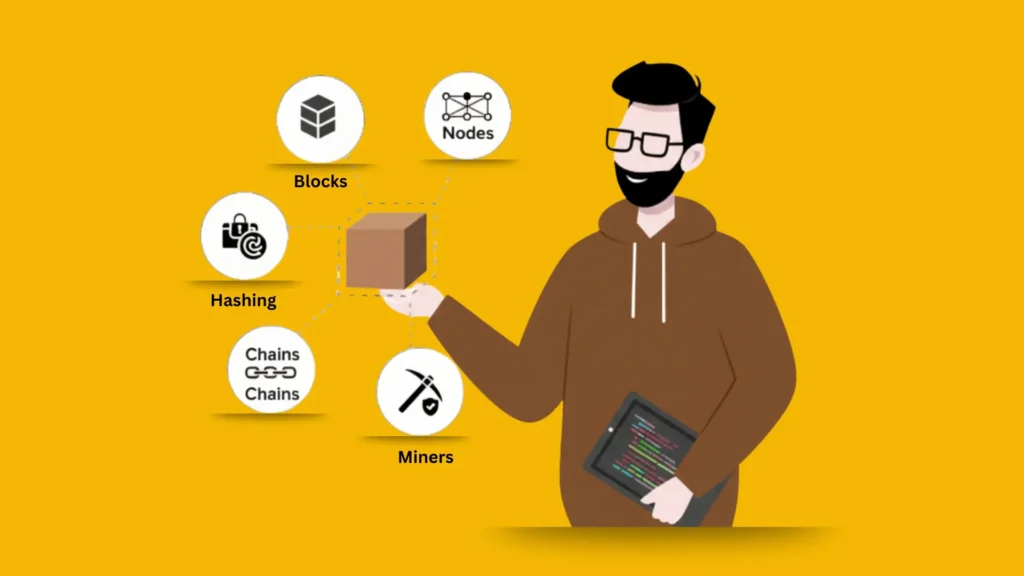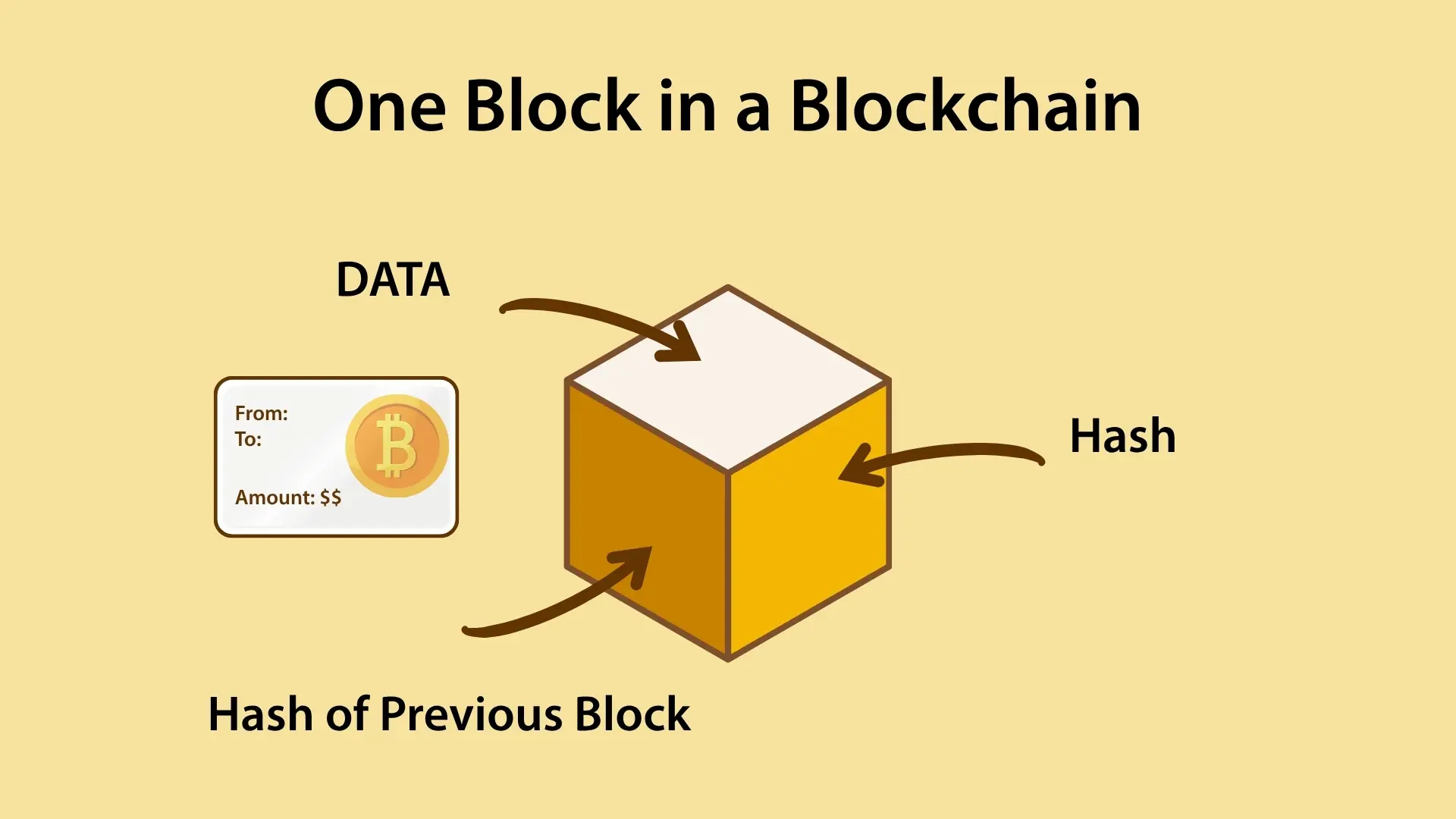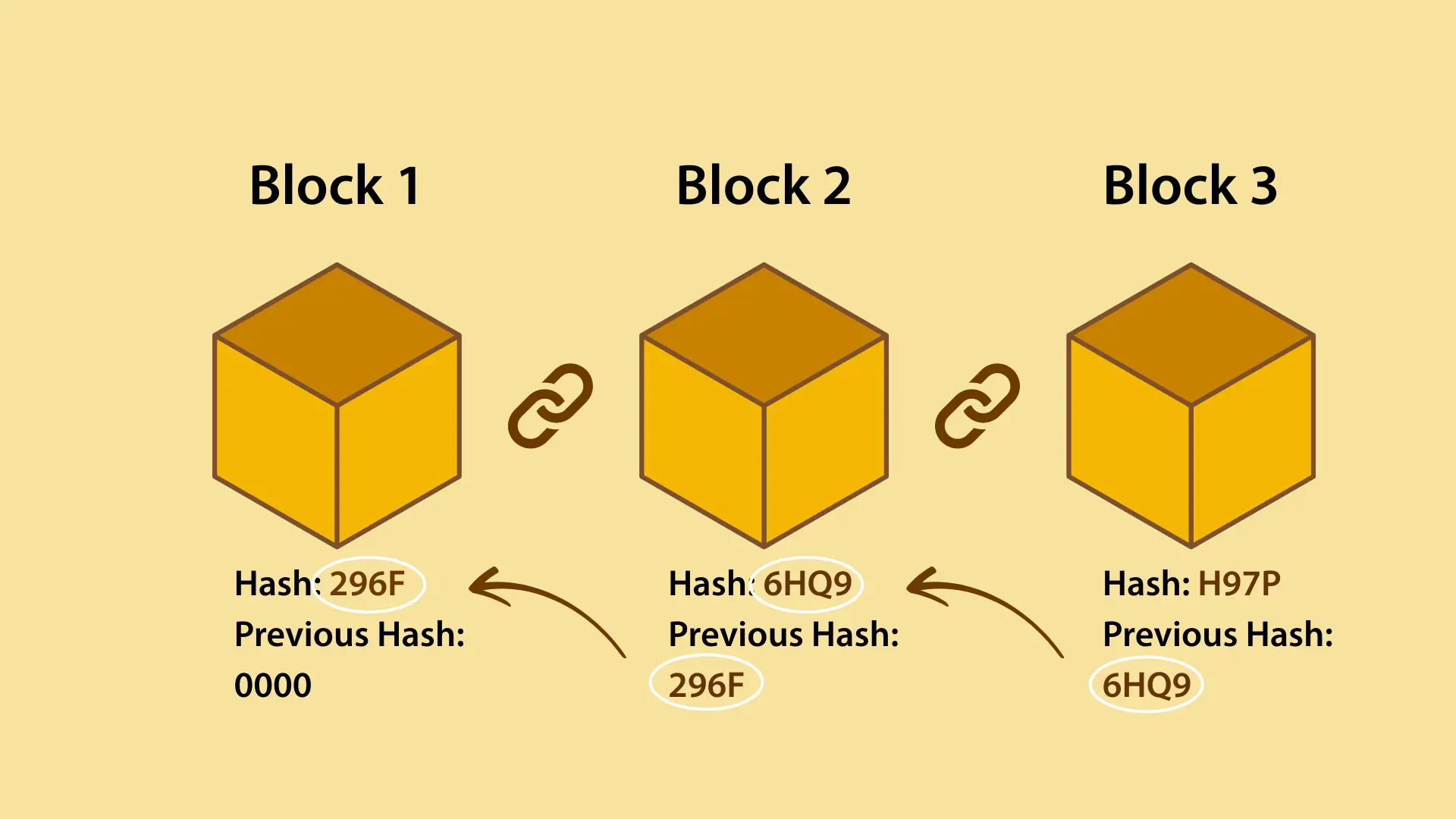
Blockchain is among the most significant transformative technologies of our time. What began as a technology for cryptocurrencies, such as Bitcoin and Ethereum, is now changing how many other industries, such as finance, healthcare, supply chain, and voting systems, utilize technology.
While blockchain might sound complex, at its core, it is quite simple. The technology is built on three simple, but powerful, end components are blocks, chains, and hashing. Once you understand how these pieces work together in the blockchain model, you will appreciate the level of trust in blockchain for transparency, security, and decentralization.
What is Blockchain?
Before we explore its parts, let’s cover some basics. Think about the blockchain as a digital record book – like a notepad that captures transactions or entries of information. The difference is that instead of being stored in one record book, it is distributed across thousands of computers (called nodes). Each node has its own copy of the record book, and whenever there is a transaction, it is updated at the same time on all nodes across the network. To learn more about how blockchain works in detail, check out our guide on blockchain technology
With this type of system comes three powerful attributes:
- Transparency – Everyone can see the transactions or information on the record.
- Security – No one person has control over the record.
- Immutability – Once a transaction is recorded, it cannot be changed without changing every copy on the network.
The decentralized nature of the blockchain is what makes it one of the most trusted technologies in our time.
Recommended read: IBM Blockchain for Business
Understanding Blocks

A block can be thought of as a single page of that digital notebook, a secure container for information.
Each block holds:
- Transaction data (the sender, the receiver, and the transaction amount)
- A timestamp (the date and time that the block was created)
- The hash of the previous block (which creates a link to the block that came before it)
- A nonce and the current block’s hash (the unique codes that secure the current block)
Real-Life Example
Consider a situation where you have you and a few friends documenting your daily expenses in a shared notebook.
When you finish recording a day’s expenses, you seal that page and move on to a new page, but the new page still references the previous page. This creates a series of linked pages.
You can think of blockchain in this way, an increasing number of linked pages that cannot be altered without changing all of the other pages.
The structure provided by blocks provides structure, order, and trust in a blockchain system, and ensures that anything written will stay written.
Understanding Nodes in Blockchain
Nodes are the backbone of the blockchain network. A node is any computer or device that participates in the blockchain by maintaining a copy of the distributed ledger and validating transactions. Every node acts as a checkpoint in the system, ensuring that every transaction recorded on the blockchain is accurate, verified, and consistent across the entire network.
How Nodes Work
When a transaction occurs, it is broadcasted to all nodes in the network. Each node independently verifies the transaction using a set of consensus rules, for example, confirming that the sender has sufficient funds or that the digital signature is valid. Once verified, the transaction is added to a pool of pending transactions awaiting inclusion in a new block.
After a block is successfully mined and validated, it is shared with all nodes. Each node updates its own copy of the blockchain to include the new block, ensuring every participant has the same, synchronized record of data.
Types of Nodes
Different types of nodes perform different roles, such as:
- Full Nodes: Store the entire history of the blockchain, validate transactions, and enforce all rules. They are the most trusted type of node.
- Light Nodes (SPV Nodes): Store only block headers instead of the full blockchain. They rely on full nodes to verify transactions, making them faster and less storage-intensive.
- Mining Nodes: These are specialized full nodes that perform the computational work to create new blocks and maintain network security.
- Masternodes: Found in certain networks (like Dash), masternodes perform special tasks such as transaction mixing or voting in governance decisions.
Importance of Nodes
Nodes guarantee decentralization, no single authority controls the network. If one node goes offline or is compromised, others continue functioning, keeping the system reliable and tamper-proof. This redundancy and verification across nodes are what make blockchain resilient, secure, and transparent.
In simple terms, nodes act as guardians of the blockchain, collectively maintaining the truth of every recorded transaction.
What is Miners in Blockchain
Miners play a critical role in adding new data to the blockchain and securing the network. They are responsible for verifying transactions, solving cryptographic puzzles, and creating new blocks, a process known as mining.
How Mining Works
When transactions are broadcasted, miners gather them into a candidate block. Before this block can be added to the blockchain, miners must solve a mathematical problem that involves finding a specific number (called a nonce) that produces a hash meeting certain difficulty criteria.
This process is known as Proof of Work (PoW). It requires significant computational power, making it costly and time-consuming to alter or fake transactions. Once a miner finds the correct hash, the new block is validated and broadcast to all nodes. Other nodes verify its correctness and then add it to their copy of the blockchain.
Rewards and Incentives
Mining is not just about securing the network, it also offers rewards. The first miner to solve the puzzle receives:
- Block Reward: A certain number of newly minted cryptocurrency coins (e.g., Bitcoin).
- Transaction Fees: Small fees paid by users for including their transactions in the block.
This incentivizes miners to keep the network operational and secure.
Why Miners Are Essential
Miners act as validators and protectors of the blockchain ecosystem. Their work ensures that:
- New blocks are created and linked correctly.
- Fraudulent or duplicate transactions are rejected.
- The network remains decentralized and self-sustaining.
In Proof of Work blockchains like Bitcoin, miners are the foundation of trust and security. Without them, transactions could not be validated, and the blockchain would lose its integrity.
What Does the “Chain” Mean?

With an understanding of blocks, let’s turn now to the chain that links them.
Every new block will refer to the hash of the previous block, creating a continual chain of data from the first block (the genesis block) to the most current one.
Picture It As a Train
Each block is like a train car, attached to the one before and after it. If someone were to eliminate or adjust one car (block), the entire train would derail.
This linking system protects the integrity of the data and makes any tampering noticeable. Just like rail cars keep all the trains in order as noted in the previous discussion on blocks, each block links linking other blocks in chronological order, which keeps the blockchain open, trackable, and transparent for tampering.
What is Hashing and Why is It Important?

Hashing is a fundamental component of the strength and security of blockchain. A hash is essentially a digital fingerprint or code that is generated by a mathematical algorithm. A hash can take in any type of input, including all of the data inside a block, and make it into a fixed-length string of letters and numbers. Additionally, regardless of the size of the input, the hash will always be the same length.
For instance, if you typed the word “Hello,” the hash might be a long string of random gibberish. If you change just one letter out of “Hello” to say “hello” with a lowercase h, then the entire hash will change. This makes it impossible to reverse engineer the data or any kind of input before the hash, or to find multiple different inputs that hash into the same hash.
Each block in the blockchain contains its own hash, which is determined by the contents of that block and the hash of the previous block. When a block is created, its hash is generated and recorded for reference. If someone were to change any part of the block, no matter how small, the hash would change immediately, and the link to the next block would be broken.
Hashing is very important because it provides data integrity, provides a secure link to the subsequent block, and provides a unique identity to each block. This process is what allows the blockchain to be trustworthy, immutable, and difficult to fraud.
How Blocks, Chains, and Hashing Work Together
- Transactions occur: People send or receive data, such as cryptocurrency or other digital information, which starts the process of recording on the blockchain.
- Grouped into a block: Once enough transactions happen, they are collected together into a single block that will be added to the blockchain.
- Block gets a hash: A unique digital fingerprint, called a hash, is created for the block to identify and secure it.
- Connected to the chain: Each block includes the hash of the previous block, linking them together in a continuous, unbreakable chain.
- Network verification: Other computers (nodes) in the blockchain network check the new block to ensure all data and hashes are valid.
- Permanent addition: Once verified, the block is added to the blockchain permanently and cannot be altered or deleted.
- Tamper-proof: If anyone tries to change the data, the block’s hash changes, breaking the chain and triggering rejection by the network.
- Result: This system keeps blockchain secure, transparent, reliable, and trustworthy for all participants.
Mining and Proof of Work (Simplified)
In many blockchains, such as Bitcoin, new blocks are added by means of mining. Miners are special computers that compete against each other to solve mathematical puzzles that are difficult to solve. When a miner solves a puzzle, a new block is created, and the miner earns a reward, usually in cryptocurrency. Each puzzle involves finding a number, called a nonce, that makes the hash of the new block meet certain rules, like starting with a specific number of zeros. This process is called Proof of Work (PoW). PoW means that it requires a large investment of energy and time to create a block, and it helps protect the network from being altered or from spammy transactions, and it adds an extra layer of security. In order to change the past transaction referenced in a block, a malicious person would have to redo all of the work for all of the blocks back to that transaction, which is almost impossible.
Learn more from: Bitcoin.org – Proof of Work Explained
Why Blockchain is Trusted
The trustworthiness of blockchain is due to the collaborative harmony of blocks, chains, and hashing that work to create a secure and reliable environment. It is decentralized, meaning that it is not a single entity or organization that controls it. It is indexed, allowing all actors to see the same data from their distributed access points. Once data is added, it cannot be changed and is immutable. Hashing ties the functionality of each block together with the subsequent block, rendering it safe. Each transaction is verified by multiple computers on the network. This makes the utility of blockchain more than just about cryptocurrency; it has clear utility for supply chain tracking, healthcare records, voting, and digital identity.
Challenges and Limitations
While blockchain technology is transformative, it does face certain imperfections.
The most important ones are:
- Setting aside the fact that PoW networks use exorbitant amounts of energy.
- Scaling Issues: The larger the network, the slower the transaction will be.
- Storage: As blockchains evolve, blockchains get heavier.
- Complexity: It requires technical know-how.
Though emerging solutions like PoS and Layer 2 scaling solutions are providing solutions to these problems.
(Source: Ethereum.org – Proof of Stake)
Why Blockchain is Secure and Transformative
Though blockchain may seem complicated, it is really based on three simple ideas: blocks, chains, and hashing. Blocks hold information securely; chains create the correct order of that information; and hashing secures everything in a way that can never be changed. Put all three ideas together, and you create an open, trust-protected, tamper-proof system; in other words, blockchain technology.
With more sectors and industries using blockchain technology, the idea of blockchain is much bigger than just cryptocurrency. Blockchain is helping to create a future of trust, transparency, and effectiveness, where businesses and people can share data and value, free of fraud or manipulation and blockchain is already changing industries, such as finance, healthcare and supply chains throughout the world.
Nadcab Labs is a trustworthy blockchain development partner that cares more about making our clients partners; we are advocates of using blockchain technology to make safe digital systems that are transparent and innovative. We will create a blockchain platform that provides trust and perpetual value to people and businesses alike through experience and technology.
Frequently Asked Questions
What is a block in blockchain?
A block is a digital container that stores transaction data, timestamps, and unique hashes, linking securely to the previous block in the chain.
Who are miners in blockchain?
Miners verify transactions, solve cryptographic puzzles, and add new blocks to the blockchain, earning rewards through cryptocurrency and transaction fees.
Why is blockchain secure and trusted?
Blockchain is secure because it is decentralized, immutable, and verified by multiple nodes. Once data is recorded, it cannot be changed or deleted.
What is a node and its role in blockchain?
A node is a computer that maintains a copy of the blockchain, verifies transactions, and ensures all data is synchronized across the network.
What are the main components of blockchain?
The main components of blockchain are blocks, nodes, miners, chains, and hashing. Together, they create a secure, transparent, and decentralized digital system.
How do blocks, chains, and hashing work together?
Transactions are grouped into blocks, secured by hashes, and linked in a chain. This makes blockchain tamper-proof, traceable, and transparent.
What are the main challenges of blockchain technology?
Key challenges include energy consumption, scalability, storage requirements, and technical complexity. New methods like Proof of Stake help solve these issues.
What is hashing in blockchain and why is it important?
Hashing converts data into a fixed-length code. It ensures security and immutability—if any data changes, the hash changes, exposing tampering instantly.







